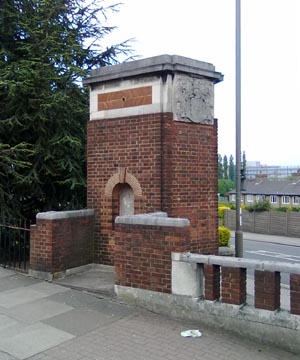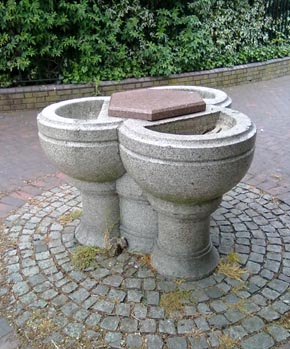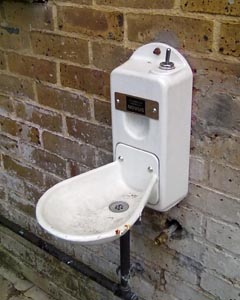WANDLE PARK MERTON
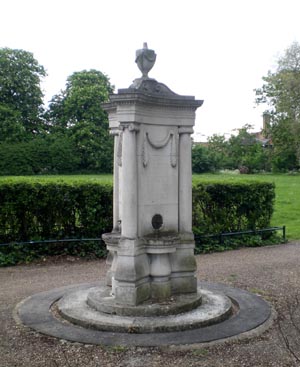
Following the course of the River Wandle north from Abbey or Merton Mills, the river snakes around the superstore and then runs alongside Merton High Street. It then continues on its way to the Thames, northwards along the western side of
Wandle
Park, a National Trust property with an entrance from the High Street almost opposite Colliers Wood underground station. Entering
Wandle
Park there is a distinctive fountain just inside the gates. One of several inscriptions on the fountain record the opening of the park on July 11 1907, it being vested in the National Trust for places of historic interest or natural beauty. A further inscription details the giving of the grounds to the people of Wimbledon and Merton by John Feeney of
Birmingham and Berkswell, "a lover of beauty and his fellow men". The Moat,
Coventry Road, Berkswell in Warwickshire was the home of John Feeney (1835 - 1905), proprietor of The Birmingham Post & Mail, who remodelled the estate in the 19th century. He took over the Birmingham Post & Mail from the founder, his father, John Frederick Feeney. When the Berkswell estate was finally broken up in 1953, there were 20 lots including two lodges, nine cottages, two farms and the The Moat, a total of some 222 acres. Other gifts by John Feeney included the church bells where he lived. The fountain is now dry.
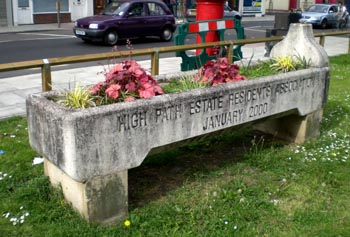
Head towards South Wimbledon underground station from the Wandle Park gates on Merton High Street and on the left there are two troughs, about 50 yards apart on the grass verge to the road. On first sight they appear to be historic horse troughs being reused as flower tubs. Closer inspection reveals that they are concrete and not granite and were put there by the High Path Estate residents in Millennium year. Now weathered they make a valuable contribution to the decor of this busy High Street.
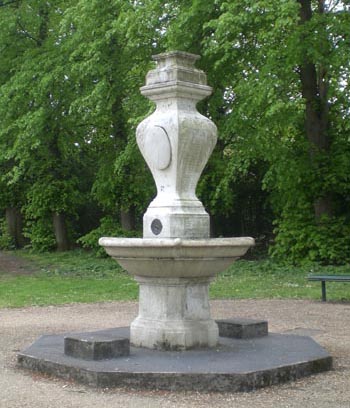
Wandle
Park, Merton has considerable history. Colliers Wood refers to the colliers or charcoal burners who were located in the area and Merton Priory stood on the site of the superstore opposite the park southern entrance. The Croydon to Wandsworth Surrey Iron Railway ran alongside the river here and was the world's first public railway opened in 1803. In the centre of the park there is a second impressive fountain albeit now dry. Erected in 1911, this fountain was a result of a private subscription to the memory of Harry Pollard Ashby (1809 - 1892) and his son-in-law Robert Bloomfield Fenwick (1835 - 1897). Both men lived in
Wandle
Park in the 19th century and were instrumental is establishing it as a public amenity. The former was a local artist who worked with John Constable. He was active in local affairs and the Church. His son in law was an alderman of Surrey County Council and a justice of the peace. Through his influence and generosity All Saints Parish was founded and the church erected. The sculplture is based on a classical water carrier and is by Mr Fritz Roselieb, gold medallist of the Royal Academy and of the London and City Guilds and designer of the Wilfred Lawson Memorial at Cockermouth
KING GEORGES PARK
As the River Wandle progresses northwards prior to entering the
Thames, it passes through the substantial King George's Park in Wandsworth, the river forming the eastern boundary. Originally called
Southfields
Park it was transformed in the 1920s and formally opened by King George V in 1938. There are several water features to be seen. Just outside the western entrance to the park at the junction of Buckhold and Merton Roads is this brick built double fountain, now without its basins and spouts and dry. Inscriptions on it record the architect and the craftsman as Messrs. Elkington and Cashmore respectively.
In the park itself near the eastern boundary entrance lies a triple basin granite fountain, now dry and without some of its original ornamentation. Ironically on the Tennis Hut nearby is a drinking fountain that is working. This modern device resembles a urinal and could be mistaken for one. One wonders whether it would have been better to put the historic fountain back in water rather than erect a modern monstrosity?
The most attractive water feature in the park however is without doubt the lake and fountain as illustrated. While ducks paddle their way through the water, the fountain gushes forth in the sunlight.
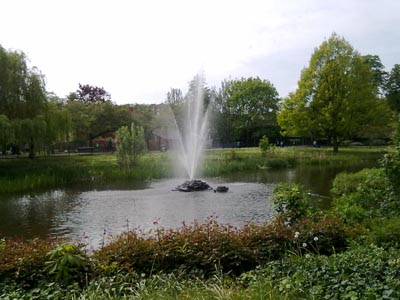
The River Wandle flows past the Wandsworth Brewery before finally entering the River Thames. The Ram Brewery is now closed but remains a substantial historic location around which flows the traffic one way system in the centre of the town. The brewery required a substantial, good quality water supply and this need was met with a well and borehole first dug in 1877. It was further deepened in 1898 to a total depth of 600 feet. Passing through the London Clays, the well penetrated the Woolwich and
Reading beds at a depth of 170 feet and the Thanet Sands at 272 feet, finally penetrating the underlying chalk at a depth of 334 feet. When first dug the level of the water was about 30 feet down, but the need for more water and the general lowering of the water table resulted in the later deepening of the well. The well shaft extended for the first 170 feet and thereafter it was bored.
The Young's Ram Brewery has been a familiar local landmark for over 150 years. Opened in 1831, the site has contributed much to the borough's social and historic fabric. The brewery closed in 2006 and the site is now being considered for sympathetic redevelopment.



 Springs, Spouts, Fountains and Wells of the River Wandle - 7
Springs, Spouts, Fountains and Wells of the River Wandle - 7


